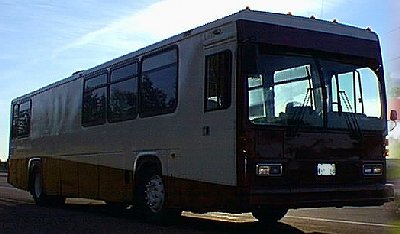
![]() his is the first bus that I have attempted and I am sure there are several things that could have been done in other and perhaps better ways. Our conversion took 6 months to "complete" and all of the work was done at our shop.
his is the first bus that I have attempted and I am sure there are several things that could have been done in other and perhaps better ways. Our conversion took 6 months to "complete" and all of the work was done at our shop.
This unit was originally purchased in the spring of '85 at the price of $375,000 CDN and worked as a Halifax city transit bus until the spring of '97. The Saab bus was a major change in direction for the City of Halifax who had primarily used MCI's. The fact that these buses had a smooth body design and a fuel squeezer that delivered 12 mpg became the big reasons for the City to purchase 12 units. Time proved the buses to be very reliable but as a city bus the drivers were not happy. Saab has a high ratio gear system and the electric over air braking system was not great for constant city driving plus the fact that these are of European manufacture and do take getting used to. The mechanics that I spoke with claimed these buses were far more reliable and easier to work on than the MCI's in the fleet but in the end, the drivers convinced transit officials that these buses were better suited to highway use than city (they were right) and therefore all 12 were taken out of service early.
Susan and I learned of this in the fall of '97 and started to give thought to the conversion idea. By December we were on our way to Florida and stopping in at every little dealer there was that sold anything that remotely resembled a motorhome or conversion, garnering information from any and every one who was willing to share ideas. We spent the better part of January trying to convince ourselves that this is really what we needed, although we belonged to a travel trailer group and at that time owned a 30 foot travel trailer.
The dilemma we found ourselves in, though, was that with our travel trailer, the sleeping arrangements were never really quite as adequate as we required them to be for our 2 children, so upon returning to our home in New Brunswick, Canada, we decided that one of these buses may be worthwhile looking into. Near the end of January we found ourselves looking at a 40 foot city bus parked in our yard!
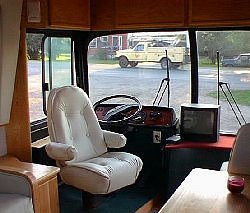 We began by stripping the interior and pouring over every brochure and tidbit of information that we could find on the internet. That, of course, is how we found Bus Nut Online and many other related links. I am probably too much of a perfectionist to agree that it takes years and years to accomplish such a task, and more importantly, I am a strong believer that, not only can a custom conversion be as good as a factory conversion, it can actually be better because the builder and designer is also the customer. So, as in my case, we found that there were no floor plans available on the public market that could satisfy the needs of our family and still keep a dignified motorcoach appearance.
We began by stripping the interior and pouring over every brochure and tidbit of information that we could find on the internet. That, of course, is how we found Bus Nut Online and many other related links. I am probably too much of a perfectionist to agree that it takes years and years to accomplish such a task, and more importantly, I am a strong believer that, not only can a custom conversion be as good as a factory conversion, it can actually be better because the builder and designer is also the customer. So, as in my case, we found that there were no floor plans available on the public market that could satisfy the needs of our family and still keep a dignified motorcoach appearance.
Most of the first 2 months were devoted to designing a floor plan that would be efficient and appealing, not only to us, but to others, as I have the belief that most everything is for sale or will be for sale in future years. The design we finally settled on offers an 8 x 10 master bedroom with a queen size mattress with custom ordered, 2.2 lb. density, 35 lb. compression foam allowing us to keep the thickness reduced to 4 inches. Below the bed is a storage compartment and inside engine access. In here we have 55 gallons of fresh water storage and a 6 gallon electric water heater. We also installed a gauge for pressure that will tell us our on board water pressure, and if we feel that it is too great we can adjust it. Also, if it is too low, we can use our on board pump to maintain a minimum of 42 lbs. of pressure.
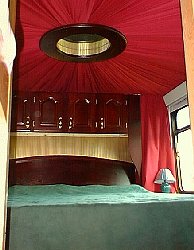 The woodwork in the bedroom is birch with a mahogany finish and 3 coats of lacquer. We also included a tip-out laundry basket, a very useful item especially with children, as most RVers usually resort to a clothes basket stuffed in the shower. The bedroom ceiling has approximately 20 yards of pleated burgundy broadcloth with a small recessed round mirror in the center of the room. This effect has drawn many compliments, and was quite easy to achieve.
The woodwork in the bedroom is birch with a mahogany finish and 3 coats of lacquer. We also included a tip-out laundry basket, a very useful item especially with children, as most RVers usually resort to a clothes basket stuffed in the shower. The bedroom ceiling has approximately 20 yards of pleated burgundy broadcloth with a small recessed round mirror in the center of the room. This effect has drawn many compliments, and was quite easy to achieve.
The children have their own bunk bed area with 2 inch firm mattresses matching the master bedroom. Across from the bunks is a four piece bathroom, 42 inches by 72 inches. We installed a ceiling exhaust fan and the other regular amenities. Woodwork is red oak accented with brass accessories. We chose to use burgundy cloth shower curtains cut to fit and then draped giving an elegant effect, but yet more spacious that an enclosure. The bathroom door is a sliding raised panel hollow core door.
For the kitchen area we put in a rustic birch floor and all the remaining woodwork, as in the rest of the coach, with the exception of the master bedroom, is solid red oak with 3 coats of natural lacquer finish. We installed a single stainless steel RV sink, and discreetly below we installed a built-in automatic RV dishwasher. The cupboards are plentiful and the counter space is very adequate also.
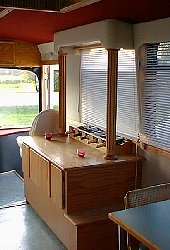 The kitchen/living room areas, from our experience, is very important, and, therefore, we wanted to give as much open floor space as possible to these areas and furthermore, with the use of mirrors in the ceiling in the main area, and no cupboards over the sofa and dining areas we created the illusion of even greater space. The two large mirrors are set in urethane for safety and, as an extra precaution, a large safety screen is used while the coach is in motion. We have tested the bus on some pretty rough roads with no sign of glass problems.The mirrors are recessed and a brass tambour gives the illusion of increased depth. White leather was used for the sofa, captain and copilot's chairs and all window dressings throughout the coach. Forest green leather was used on the lower part of the dash area and the 2 chairs in the dining area.
The kitchen/living room areas, from our experience, is very important, and, therefore, we wanted to give as much open floor space as possible to these areas and furthermore, with the use of mirrors in the ceiling in the main area, and no cupboards over the sofa and dining areas we created the illusion of even greater space. The two large mirrors are set in urethane for safety and, as an extra precaution, a large safety screen is used while the coach is in motion. We have tested the bus on some pretty rough roads with no sign of glass problems.The mirrors are recessed and a brass tambour gives the illusion of increased depth. White leather was used for the sofa, captain and copilot's chairs and all window dressings throughout the coach. Forest green leather was used on the lower part of the dash area and the 2 chairs in the dining area.
We designed and built the sofa over the wheel well and the curved oak arms were quite elegant but actually involved a simple process utilizing steam and lamination. The sofa will extend to a 48 inch width for extra sleeping. Across from the sofa is a large fully functional bar with 2 fluted oak pillars, an overhead mirror, and a built in wine rack. A large center locking drawer for liquor and shot glasses, etc., with storage compartments on either side, for items of your choice, completes this area. The drawer facing and doors of the cabinet will soon have a covered bridge and roses carved in the wood. The ceiling is an automotive headliner, a burgundy velour with 1/4 inch foam backing. This product is very cleanable and low maintenance.
The interior height in the coach, with the exception of the master bedroom, is 6 foot 10 inches. The master is 5 foot 7 inches. The exterior height is 9 foot 6 inches and width 102.5 inches. The gray water holding tank is 50 gallons, black water is 55 gallons. We have yet to install a 4000 watt Onan generator which we have on hand. The bus is powered by a 6 cylinder turbo charged diesel, with an electric automatic transmission. The exterior side walls are stainless steel with fiberglass nose and tail and center compartment covers. The roof is one piece aluminum.
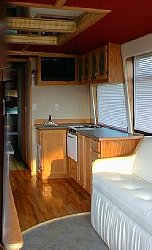 There will be a flow stripe along the side with a matching triple stripe at the roof line and the large side panels will feature paintings of local country covered bridges in rural settings, one on each side of the unit. The back of it will have a mountain scene. The name we have chosen and fondly refer to the bus as is "MIRROR IMAGE".
There will be a flow stripe along the side with a matching triple stripe at the roof line and the large side panels will feature paintings of local country covered bridges in rural settings, one on each side of the unit. The back of it will have a mountain scene. The name we have chosen and fondly refer to the bus as is "MIRROR IMAGE".
I tested the bus to get a better idea of cruising speed and approximate top end. I was surprised to find she cruises comfortably at 72 MPH and reaches 85 MPH. This bus is also equipped with a retarder that seems to be a great asset in braking. I have to read more on this system but as I see it , the unit triggers a fluid back pressure but is quiet in comparison to a Jacob's brake.
The "in progress" pictures that you see were taken 5 months after we purchased this unit. There are, and probably always will be, changes, additions and alterations in store for this motor coach, but after many, many, many long days, our family has now taken several small test outings and truly feel that this coach is a delightful home away from home.
Perhaps we'll be in your area some day or you in ours, and once again we may have the chance to chat about buses. Please feel free to e-mail us if you have any further questions, inquiries, or suggestions.
